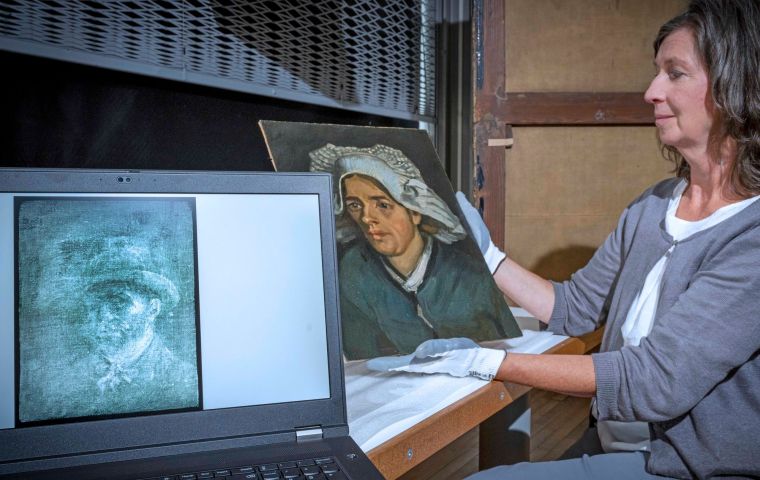MercoPress. South Atlantic News Agency
Scotland “blessed” with a second Van Gogh, an unknown self portrait hidden under another masterpiece
 An X-ray image showing the hidden Vincent van Gogh painting
An X-ray image showing the hidden Vincent van Gogh painting Experts at the National Galleries of Scotland have discovered a previously unknown self-portrait of Vincent Van Gogh, when a canvas was X-rayed before an exhibition.
The hidden self-portrait was covered by layers of glue and cardboard on the back of an earlier work called Head of a Peasant Woman.
The gallery's senior conservator Lesley Stevenson said she felt “shock” to find the artist “looking out at us”.
“When we saw the X-ray for the first time, of course we were hugely excited. This is a significant discovery because it adds to what we already know about Van Gogh's life.”
The Dutch artist often re-used canvases to save money, turning them over and then working on the other side.
His work did not sell during his lifetime and his fame came only after his death in 1890, at the age of 37.
Van Gogh became one of the most famous and influential figures in Western art history.
Head of a Peasant Woman entered the National Gallery of Scotland (NGS) collection in 1960, as part of a gift from a prominent Edinburgh lawyer.
It shows a local woman from the town of Nuenen in the south of the Netherlands, where the artist lived from December 1883 to November 1885.
It is thought that Van Gogh later painted the self-portrait on the other side at a key moment in his career, after he moved to Paris and was exposed to the work of the French impressionists.
About 15 years after his death, Head of a Peasant Woman was loaned to an exhibition at the Stedelijk Museum, Amsterdam.
The self-portrait is hidden beneath glue and cardboard It is believed that this is when the canvas was stuck down on cardboard before being framed.
It appears that Peasant Woman was considered more “finished” than the self-portrait on the other side.
The painting changed hands several times and in 1923 was acquired by Evelyn St Croix Fleming, whose son, Ian, became the creator of James Bond.
It was not until 1951 that it came to Scotland, having entered the collection of Alexander and Rosalind Maitland, who later donated it to the NGS.
Experts at the gallery said it may be possible to uncover the hidden self-portrait, but that the process of removing the glue and cardboard will require delicate conservation work.

![“Working directly with President [Donald] Trump and Congress, we accomplished what no one else could,” Patel stressed](/data/cache/noticias/108417/130x80/fbi.jpg)


Top Comments
Disclaimer & comment rules-

Read all commentsPerfect! Scotland never painted anything. The era of Victorian piracy portrayed at just as good a time as it is now. Independence wishes in the air.
Jul 16th, 2022 - 06:35 pm 0And Van Gogh suffering in the delicate French hands. SAD!
Commenting for this story is now closed.
If you have a Facebook account, become a fan and comment on our Facebook Page!